
|

|
Medieval Icelandic Manuscripts
 |
Most of the medieval Icelandic literature that survives was preserved in the form of manuscripts from the 13th century and later. Until inexpensive paper became available in the 16th century, the only suitable material for the leaves of books was vellum, made from animal skins. Typically, calfskin was used. |
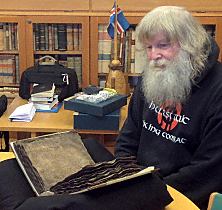 |
 |
The leaves are thin, supple and probably started out nearly as white as modern paper. A manuscript from c.1260 in an excellent state of preservation is shown to the right. However, most surviving manuscripts have been darkened by centuries of handling (left). |
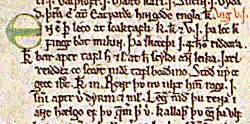 |
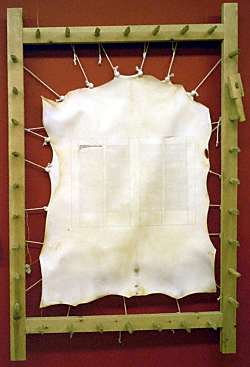 |
While the details of the process by which the calf skins were converted to vellum in Iceland have been lost, it's clear that they differ from those used in continental Europe at the time. After the skin was processed to remove hair, it was set into a frame to stretch it as it dried, in order to create a flat leaf. (The photo to the left shows a frame holding a skin in which several additional steps have already been performed. In actual practice, these steps were performed one at a time.) The drying process was carefully controlled in order to create high quality vellum. Water was applied to dampen the skin if it were drying too quickly, and chalk was applied to draw out moisture if it were drying too slowly. |
|
After the skin was dried, it was cut to size. For the larger books (folio size), the skin was folded in half to make two leaves, and thus four pages (right). The sheets were gathered, usually into groups of eight sheets. Larger books were typically written in two columns. The columns and lines were laid out and marked with pinpricks, and then marked with fine, light lines. Traces of these lines survive in some manuscripts (and are surprisingly visible in a few). |
 |
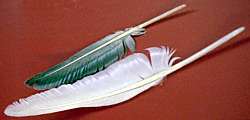
|
Finally, the scribe began the laborious process of writing the book. Quill pens were used, typically from a goose or swan (left). The point was carefully trimmed, then hardened by heating in hot sand. Quills needed regular sharpening, so that the written line did not become too broad. Ink was made from berries, using some of the same durable dyes used for coloring "black" cloth. (The dye is closer to a very dark blue, rather than being truly black.) |
The process of making a book was both time consuming and expensive. For Flateyjarbˇk, the skin of 113 calves was used to create the 225 leaves that make up the book. Today, it can be hard to conceive of the value of that raw material. At the time the volume was created, even a single milk cow might mean the difference between a family surviving or starving to death over the winter. To sacrifice 113 potential milk cows to make one book speaks to the importance and value these books had in this era.
Two scribes took two years to copy and illuminate the stories that make up Flateyjarbˇk. The scribes themselves tell us of the difficulty of their work in the form of marginal notes in some of the Icelandic manuscripts. One comments, "Writing bores me," and another, "O, how difficult it is to write: it dulls the eyes, presses on the kidneys, and torments all the joints."
| Some claim that despite the cost, books were available to all, but that
conclusion seems unjustified. Regardless of the labor needed to create the book,
just the calves alone seem so valuable that it
seems more likely that vellum books were only available to the wealthy.
Flateyjarbˇk was written for Jˇn Hßkonarson, a wealthy chieftain at VÝidalstunga (right), and was created at the monastery at Ůingeyrar. |
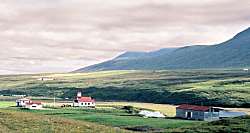 |

|
After the writing was complete, the groups of sheets (called gatherings) were sewn together and bound between wooden boards held together with straps. While there's no evidence the boards were decorated, many manuscripts are decorated with illustrations (right) and other illumination. A wide variety of pigments was available (left). |
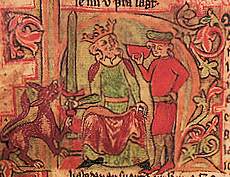 |
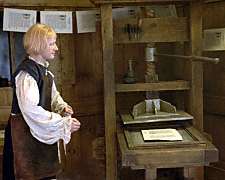 |
The coming of the printing press did not fundamentally change the way books were made in Iceland. The first press in Iceland was installed at Breiabˇlsstaur (right), in about 1530. The press was a church monopoly and only religious works were published. |
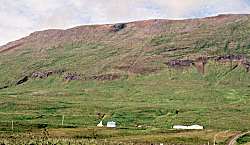 |
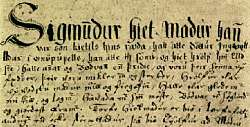 |
However, the introduction of inexpensive paper made it much more affordable for someone to make his own copy of a book, as well as much easier, since writing on paper is easier than on vellum. The image to the left shows the first leaf of a 17th century paper manuscript of Valla-Ljˇts saga. This is an example of a medieval text that has survived only in late paper manuscripts; no vellum manuscripts of the saga are known to have survived. |
 |
Many paper copies were made, and the vellum copies, while still prized as heirlooms, lost their usefulness. Many were probably discarded, or used for other purposes. Vellum leaves have been found that were used as sieves, as insoles of shoes, and as patterns for clothing (left, a leaf of Sturlunga saga used as a pattern for children's clothing). A ship load of manuscripts being transported from Iceland to Denmark was lost at sea in 1682; when ┴rni Magn˙sson tried to trace what had been lost, he was told it was "a load of parchment book rubbish." The surviving sagas themselves attest to the lost literature. Some of the sagas refer to stories that are not known to have survived. For example, in chapter 69 of LaxdŠla saga, reference is made to an incident in NjarvÝkinga saga, an otherwise unknown saga. |
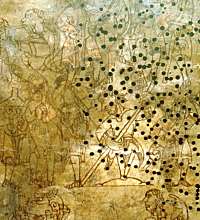 |
The comparison between paper and vellum copies of the same book is interesting, since the hand, the spelling, the orthography, the modifications to the text, the linguistic traits, and the general care used to create the book imply changes in society's attitude towards the literary material.
|
By the 17th century, interest in the Icelandic literature grew in Europe, prompting ┴rni Magn˙sson's efforts to collect and preserve the existing manuscripts. Printed editions were prepared, as well as translations into Latin and modern languages. The photo to the right shows the title page of the first printed edition of Snorra Edda, published in 1665 in Copenhagen. Scholarly study of the medieval Icelandic literature has continued through today, with new editions and new translations and new scholarly analyses being published regularly. Through the centuries, the motivation for that study has varied: for political reasons; for romantic or fanciful reasons; for cultural reasons; or simply for pleasure. These are interesting stories about interesting people and events. |
 |
The surviving vellum manuscripts are difficult to interpret. In some cases, the manuscript is poorly preserved, and thus difficult to read, such as the sample from EirÝks saga rauða, shown below. But even beyond that problem, there is an art to "reading" the manuscript and converting it to standardized old Icelandic.

Because of the high cost of writing materials during the Norse literary period, and because of the time and difficulty involved in hand copying each manuscript, copyists used every trick to shorten the physical length of the manuscript. There are no line breaks or stanza breaks in poetry. Abbreviations and contractions are widely used, indicated by dots, bars, curls, curved letters, or superscript characters. Repeated words or lines are not written in full, but simply marked as repeats.
Here is a facsimile of one stanza from the poem Þrymskiviða, which tells the story of how Þór recovered his stolen hammer:

And here is a transcription, with the missing letters underlined:
Þa qvaþ þat heimdallr
hvitastr ása visi hann vel fram sem
vanir aþrir. bin
do ver þor þa bruþar lini hafi hann
iþ micla men brisinga.
Note the marks of suspension used to indicate missing letters: in the second word (qvaþ), the symbol over the "q"; in the third word (þat), the symbol over the "þ"; in the fourth word (heimdallr), the bar over the "ei"; and in the eighth word (hann), the symbol over the "h".
And here is the stanza, converted into standard old Icelandic, and broken up into lines:
Ůß kva ■at Heimdallr, hvÝtastr ┴sa-
vissi hann vel fram, sem Vanir arir-
"Bindu vÚr ١r ■ß br˙ar lÝni
hafi hann it mikla men BrÝsinga."
And a English translation:
Then Heimdall said, the whitest of the gods-
he can see far ahead as the Vanir also can
"Let's dress Thor in a bridal head-dress,
let him wear the great necklace of the Brisings."
Despite the time the separates us from the creation of the manuscripts, new material is occasionally discovered. In historic times, books were sometimes refurbished with new bindings, and old, unwanted vellum leaves were used to make new covers. When those covers are examined in modern times, occasionally better preserved text is found on the old leaves used to make the cover.

Additionally, advances in imaging technology allow text to be recovered from leaves that are illegible to the naked eye. A new imaging process is showing promise of recovering legible text from these leaves of M÷ruvallabˇk, an important manuscript containing the text of eleven sagas. In some cases, these sagas only survive in M÷ruvallabˇk or in later copies derived from M÷ruvallabˇk, so being able to recover text from these leaves would add to our knowledge of the sagas.
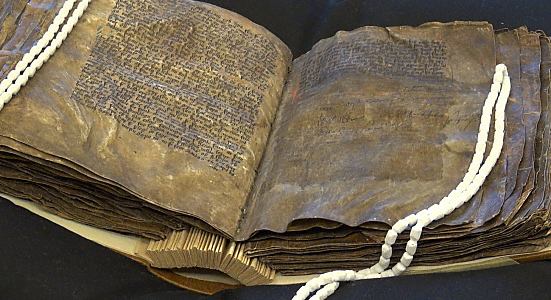 |
A fascinating example occurs in AM556a 4to, a manuscript containing Grettis saga. The manuscript contained the poem GrettisfŠrsla which tells of Grettir's sexual exploits. The poem is mentioned in chapter 52 of the saga. An early owner of the manuscript must have felt the poem was too vulgar, and so he scraped the writing off the leaves, seen beginning on the recto (right) side of the leaf in the photo, thus obliterating the only copy of the poem. Modern imaging has allowed at least some of the verses to be recovered, and indeed, they are quite vulgar, yet quite entertaining. One only wishes that more of the text was legible. |
Many interesting medieval Icelandic manuscripts are now available on-line in facsimile editions at HandrÝt.is and at Stofnun ┴rna Magn˙ssonar.
When I visited the National Library in Reykjavík during the summer of 1998, I had an opportunity to handle a 13th century manuscript. I thumbed through an Icelandic law book over 700 years old. The manuscript was in excellent condition, with highly legible script on supple leaves. I can't imagine any book published today being in as good a condition when the year 2700 rolls around. Another opportunity presented itself when Hurstwic shot our film about the saga hero Grettir the Strong. We had the opportunity to examine the oldest surviving manuscript of the saga, from the late 1400s. Again, the script was clear and legible, and the leaves were supple and robust.
|
|
ę1999-2025 William R. Short |